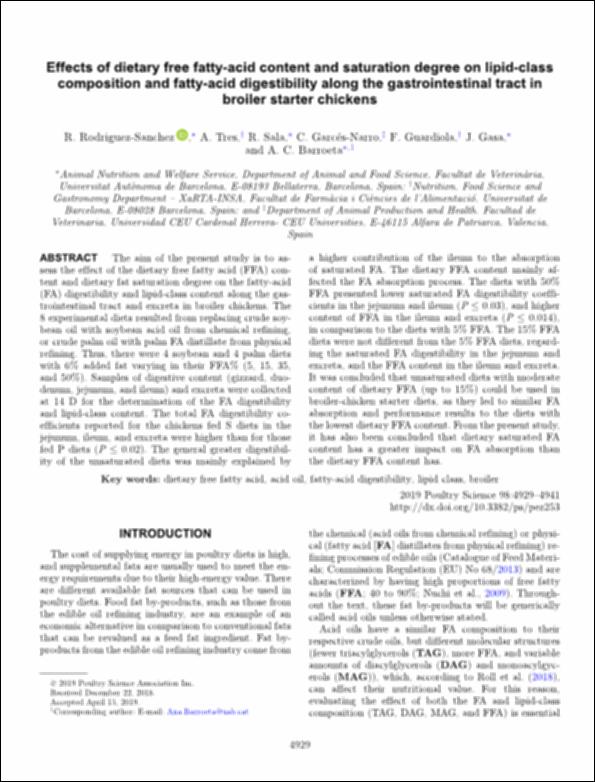Please use this identifier to cite or link to this item:
http://hdl.handle.net/10637/13362Effects of dietary free fatty-acid content and saturation degree on lipid-class composition and fatty-acid digestibility along the gastrointestinal tract in broiler starter chickens
| Title: | Effects of dietary free fatty-acid content and saturation degree on lipid-class composition and fatty-acid digestibility along the gastrointestinal tract in broiler starter chickens |
| Authors : | Rodríguez Sánchez, Raquel Tres, A. Sala Pallarés, Roser Garcés Narro, Carlos Guardiola Ibarz, Francesc Gasa Gaso, Josep Barroeta Lajusticia, Ana Cristina |
| Keywords: | Aceites y grasas en nutrición.; Lipids in nutrition.; Ácidos grasos.; Pollos - Alimentación.; Chickens - Feeding and feeds.; Fatty acids. |
| Publisher: | Elsevier |
| Citation: | Rodríguez-Sánchez, R., Tres, A., Sala, R., Garcés-Narro, C., Guardiola, F., Gasa, J. & Barroeta, A.C. (2019). Effects of dietary free fatty-acid content and saturation degree on lipid-class composition and fatty-acid digestibility along the gastrointestinal tract in broiler starter chickens. Poultry Science, vol. 98, i. 10 (oct.), pp. 4929-4941. DOI: https://doi.org/10.3382/ps/pez253 |
| Abstract: | The aim of the present study is to assess the effect of the dietary free fatty acid (FFA) content and dietary fat saturation degree on the fatty-acid (FA) digestibility and lipid-class content along the gastrointestinal tract and excreta in broiler chickens. The 8 experimental diets resulted from replacing crude soybean oil with soybean acid oil from chemical refining, or crude palm oil with palm FA distillate from physical refining. Thus, there were 4 soybean and 4 palm diets with 6% added fat varying in their FFA% (5, 15, 35, and 50%). Samples of digestive content (gizzard, duodenum, jejunum, and ileum) and excreta were collected at 14 D for the determination of the FA digestibility and lipid-class content. The total FA digestibility coefficients reported for the chickens fed S diets in the jejunum, ileum, and excreta were higher than for those fed P diets (P ≤ 0.02). The general greater digestibility of the unsaturated diets was mainly explained by a higher contribution of the ileum to the absorption of saturated FA. The dietary FFA content mainly affected the FA absorption process. The diets with 50% FFA presented lower saturated FA digestibility coefficients in the jejunum and ileum (P ≤ 0.03), and higher content of FFA in the ileum and excreta (P ≤ 0.014), in comparison to the diets with 5% FFA. The 15% FFA diets were not different from the 5% FFA diets, regarding the saturated FA digestibility in the jejunum and excreta, and the FFA content in the ileum and excreta. It was concluded that unsaturated diets with moderate content of dietary FFA (up to 15%) could be used in broiler-chicken starter diets, as they led to similar FA absorption and performance results to the diets with the lowest dietary FFA content. From the present study, it has also been concluded that dietary saturated FA content has a greater impact on FA absorption than the dietary FFA content has. |
| Description: | Este artículo se encuentra disponible en la siguiente URL: https://www.sciencedirect.com/science/article/pii/S0032579119480139?via%3Dihub#! |
| URI: | http://hdl.handle.net/10637/13362 |
| Rights : | http://creativecommons.org/licenses/by-nc-nd/4.0/deed.es |
| ISSN: | 0032-5791 1525-3171 (Electrónico) |
| Issue Date: | 1-Oct-2019 |
| Center : | Universidad Cardenal Herrera-CEU |
| Appears in Collections: | Dpto. Producción y Sanidad Animal, Salud Pública Veterinaria y Ciencia y Tecnología de los Alimentos |
Items in DSpace are protected by copyright, with all rights reserved, unless otherwise indicated.


